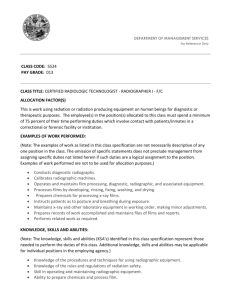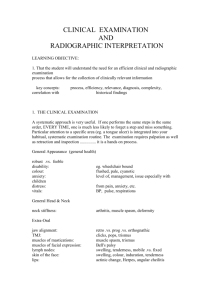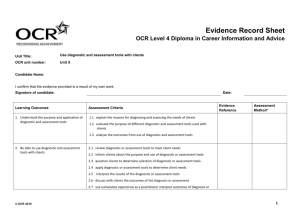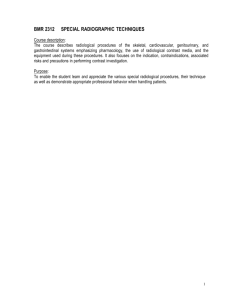F06V 04 (CI.A3)
advertisement
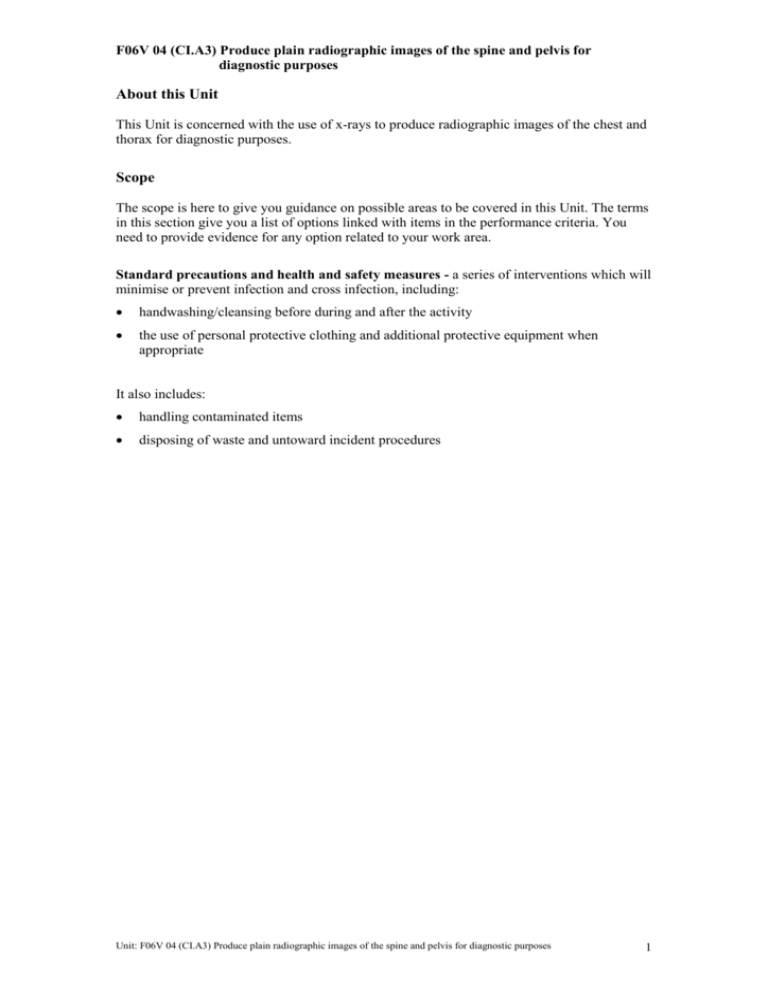
F06V 04 (CI.A3) Produce plain radiographic images of the spine and pelvis for diagnostic purposes About this Unit This Unit is concerned with the use of x-rays to produce radiographic images of the chest and thorax for diagnostic purposes. Scope The scope is here to give you guidance on possible areas to be covered in this Unit. The terms in this section give you a list of options linked with items in the performance criteria. You need to provide evidence for any option related to your work area. Standard precautions and health and safety measures - a series of interventions which will minimise or prevent infection and cross infection, including: handwashing/cleansing before during and after the activity the use of personal protective clothing and additional protective equipment when appropriate It also includes: handling contaminated items disposing of waste and untoward incident procedures Unit: F06V 04 (CI.A3) Produce plain radiographic images of the spine and pelvis for diagnostic purposes 1 F06V 04 (CI.A3) Produce plain radiographic images of the spine and pelvis for diagnostic purposes SPECIFIC EVIDENCE REQUIREMENTS FOR THIS UNIT Simulation: Simulation is NOT permitted for any part of this unit. The following forms of evidence ARE mandatory: Direct observation: Your assessor must observe you in real work activities which provide a significant amount of the performance criteria for most elements in this unit. For example how you communicate with the individual to gain the information required, the steps you would take to ensure all the required safety procedures are followed. Reflective Accounts/professional discussion: These are recordings of your real work practice, which show your understanding of the principles and process of image collection and how you ensure that the image is checked and verified. You will need to describe and explain the methods you use to gain information record it and verify its accuracy. Competence of performance and knowledge could also be demonstrated using a variety of evidence from the following: Questioning/professional discussion: May be used to provide evidence of knowledge, legislation, policies and procedures which cannot be fully evidenced through direct observation or reflective accounts. In addition the assessor or expert witness may also ask questions to clarify aspects of your practice. Expert Witness testimony: Can be a confirmation/authentication of the activities described in your evidence which your assessor has not seen. This could be provided by a work colleague or an external individual you deal with on a regular basis. Products: For this unit, products may include records and reports related to the treatment of an individual. You need not put confidential records in your portfolio; they can remain where they are normally stored and be checked by your assessor and internal verifier. If you do include them in your portfolio they should be anonymised to ensure confidentiality Assignments/projects: you may have studied some anatomy or health and safety related to your job role. You may have completed some formally assessed work as part of an in service or external course, this may provide evidence of some parts of the knowledge and understanding which your assessor can use. GENERAL GUIDANCE Prior to commencing this unit you should agree and complete an assessment plan with your assessor which details the assessment methods you will be using, and the tasks you will be undertaking to demonstrate your competence. Evidence must be provided for ALL of the performance criteria, ALL of the knowledge and the parts of the scope that are relevant to your job role. The evidence must reflect the policies and procedures of your workplace and be linked to current legislation, values and the principles of best practice within the Health Sector. This will include the National Service Standards for your areas of work and the individuals you care for. All evidence must relate to your own work practice. Unit: F06V 04 (CI.A3) Produce plain radiographic images of the spine and pelvis for diagnostic purposes 2 F06V 04 (CI.A3) Produce plain radiographic images of the spine and pelvis for diagnostic purposes KNOWLEDGE SPECIFICATION FOR THIS UNIT Competent practice is a combination of the application of skills and knowledge informed by values and ethics. This specification details the knowledge and understanding required to carry out competent practice in the performance described in this Unit. When using this specification it is important to read the knowledge requirements in relation to expectations and requirements of your job role. You need to provide evidence for ALL knowledge points listed below. There are a variety of ways this can be achieved so it is essential that you read the ‘knowledge evidence’ section of the Assessment Guidance. You need to show that you know, understand and can apply in practice: Legislation, policy and good practice 1. A factual knowledge of the current European and national legislation, national guidelines and local policies and protocols which affect your work practice in relation to the use of ionising radiation, including: health and safety at work safe working methods control of infection use of hazardous materials (COSHH) waste disposal use of medical devices and product liability security within the workplace consent to radiological examinations patient identification data entry, utilisation, recording and transfer Enter Evidence Numbers 2. A working knowledge of your responsibilities and accountability under the current European and national legislation and local policies and protocols 3. A working knowledge of limitations of own knowledge and experience and the importance of not operating beyond this 4. A working knowledge of the roles and responsibilities of other team members 5. A working knowledge of clinical justification of the examination request Unit: F06V 04 (CI.A3) Produce plain radiographic images of the spine and pelvis for diagnostic purposes 3 F06V 04 (CI.A3) Produce plain radiographic images of the spine and pelvis for diagnostic purposes You need to show that you know, understand and can apply in practice: 6. A working knowledge of the information that should be given to patients: before commencing the examination during the examination on completion of the examination Enter Evidence Numbers Clinical knowledge 1. A working knowledge of gross anatomy of the human skeleton 2. A working knowledge of anatomical landmarks on the body that are relevant to radiographic imaging e.g centring points including detailed knowledge of those relevant to the spine and pelvis 3. A working knowledge of bones forming the pelvic girdle and the difference in structures and function between the male and female pelvis and the individual vertebrae forming the spinal column 4. A working knowledge of joints in the body and their movements, including detailed knowledge of those pertaining to the spine and pelvis 5. A working knowledge of gross anatomy structures of the neck 6. A working knowledge of normal and abnormal curvatures of the spine 7. A working knowledge of functions of the spinal column and pelvis and the relationships with the spinal cord, and a knowledge of the organs of the chest, abdominal cavities and pelvic contents that have a close relationship with the spine and pelvis 8. A working knowledge of common pathologies of the spine and pelvis and normal variants 9. A working knowledge of medical terminology relevant to the examination including abbreviations 10. A working knowledge of positioning terminology including abbreviations 11. A working knowledge of when additional views are required to aid diagnosis and to enhance the examination 12. A working knowledge of manifestations of patients’ physical and emotional status Technical knowledge 1. A working knowledge of production, interactions and properties of xrays 2. A working knowledge of process involved in the formation of radiographic images 3. A working knowledge of harmful effects of radiation to the human body 4. A working knowledge of ways in which images can be captured, processed and permanently stored relevant to the local department 5. A working knowledge of inter-relationship between kVp and mAs 6. A working knowledge of variables affecting exposure factors 7. A working knowledge of automatic exposure controls Unit: F06V 04 (CI.A3) Produce plain radiographic images of the spine and pelvis for diagnostic purposes 4 F06V 04 (CI.A3) Produce plain radiographic images of the spine and pelvis for diagnostic purposes You need to show that you know, understand and can apply in practice: 8. A working knowledge of technical and diagnostic quality requirements of the image Enter Evidence Numbers 9. A working knowledge of recognition of artefacts and their impact 10. A working knowledge of factors which influence the decision to repeat films or take additional views Materials and equipment 1. A working knowledge of the importance of timely equipment fault recognition and local procedures for reporting these 2. A working knowledge of equipment capabilities, limitations and routine maintenance including the quality control processes required by the operator 3. A working knowledge of types of x-ray equipment, films, film/screen combinations and receptor systems that are suitable for imaging the spine and pelvis Examination procedures 1. A working knowledge of patient’s positioning relevant to the examination 2. A working knowledge of patient orientation and appropriate use of anatomical legends Records and documentation 1. A working knowledge of local procedures and procedures pertaining to recording, collating and preparing appropriate patient documentation and images for transfer or storage according to local protocols Unit: F06V 04 (CI.A3) Produce plain radiographic images of the spine and pelvis for diagnostic purposes 5 F06V 04 (CI.A3) Produce plain radiographic images of the spine and pelvis for diagnostic purposes Performance criteria DO RA EW Q P WT 1. apply standard precautions for infection control and other appropriate health and safety measures 2. receive the patient and check his/her identification details in accordance with local protocols 3. check females of child-bearing age for pregnancy or potential pregnancy, if appropriate to the examination, and take action in accordance with local protocols 4. confirm the status of carers before the examination and, where their presence is required, adhere to local guidelines and rules 5. position the patient and adjust their clothing according to the protocols for the examination to be performed in a manner which allows an optimal outcome to be achieved while: recognising the patient’s need to retain their dignity and self respect ensuring his/her comfort as far as possible preventing the appearance of artefacts 6. align the correct tube and image receptor according to the appropriate examination technique, with anatomical legends correctly placed 7. apply, check and adjust appropriate exposure factors, collimation and radiation protection devices to minimise patient exposure whilst optimising diagnostic image quality 8. check the room prior to making the exposure to ensure that only essential, protected persons remain with the patient and that all local rules have been adhered to and take appropriate action if this does not occur 9. seek confirmation that the patient is ready before the exposure is made and maintain communication with the patient/carer to facilitate their understanding and cooperation throughout the examination DO = Direct Observation EW = Expert Witness RA = Reflective Account P = Product (Work) Q = Questions WT = Witness Testimony Unit: F06V 04 (CI.A3) Produce plain radiographic images of the spine and pelvis for diagnostic purposes 6 F06V 04 (CI.A3) Produce plain radiographic images of the spine and pelvis for diagnostic purposes Performance criteria DO RA EW Q P WT 10. observe the patient’s condition and wellbeing at all times and take appropriate action 11. process the image, correctly labelled and identified and inspect it for satisfactory technical and diagnostic quality according to local guidelines and criteria 12. make a decision with regard to the need to repeat any images, take additional images or undertake image post-processing to enhance the examination, in accordance with local policy and protocols 13. refer to the referring clinician if an abnormality is observed on the image which is likely to require further investigation or treatment, following departmental protocols 14. inform the patient/carer of the results procedure and answer or refer any questions appropriately 15. check the identification of the images against associated documents 16. record, collate and prepare appropriate patient documentation and images for transfer or storage according to local protocols 17. recognise where help/advice is required and seek it from appropriate sources. DO = Direct Observation EW = Expert Witness RA = Reflective Account P = Product (Work) Q = Questions WT = Witness Testimony Unit: F06V 04 (CI.A3) Produce plain radiographic images of the spine and pelvis for diagnostic purposes 7 F06V 04 (CI.A3) Produce plain radiographic images of the spine and pelvis for diagnostic purposes To be completed by the Candidate I SUBMIT THIS AS A COMPLETE UNIT Candidate’s name: …………………………………………… Candidate’s signature: ……………………………………….. Date: ………………………………………………………….. To be completed by the Assessor It is a shared responsibility of both the candidate and assessor to claim evidence, however, it is the responsibility of the assessor to ensure the accuracy/validity of each evidence claim and make the final decision. I CERTIFY THAT SUFFICIENT EVIDENCE HAS BEEN PRODUCED TO MEET ALL THE ELEMENTS, PCS AND KNOWLEDGE OF THIS UNIT. Assessor’s name: ……………………………………………. Assessor’s signature: ……………………………………….... Date: ………………………………………………………….. Assessor/Internal Verifier Feedback To be completed by the Internal Verifier if applicable This section only needs to be completed if the Unit is sampled by the Internal Verifier Internal Verifier’s name: …………………………………………… Internal Verifier’s signature: ……………………………………….. Date: ……………………………………..………………………….. Unit: F06V 04 (CI.A3) Produce plain radiographic images of the spine and pelvis for diagnostic purposes 8


